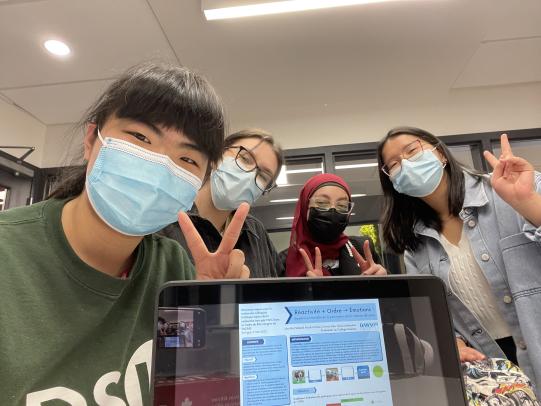
Students present neuroscience projects at 89th edition of ACFAS
Four teams of Dawson students from the Dawson Research in Neuroscience Group presented their research projects at the 89th edition of the ACFAS conference on May 9-10. In the May 9 colloquium, each team had three minutes to reveal their study, before answering questions by fellow researchers over Zoom. The May 10 colloquium gave 15 minutes for each presentation, with five minutes of questions.
Founded in 2015, the Dawson Research in Neuroscience Group brings together Dawson students and faculty, and researchers from laboratories in Greater Montreal to work on the intersection between brain imaging, neuropsychology, brain physiology and related fields.
The group is a great introduction to research and strives to make the field more accessible to students while inspiring them to develop and pursue their passions at the university level.
“Most students in the college have very little experience with research, so we offer them the tools and opportunity to explore it through neuroscience,” said Hélène Nadeau, founder of the Dawson Research in Neuroscience Group.
“I am very proud of them, they worked incredibly hard even when, as so often happens in research, the hurdles seemed insurmountable,” she added.
“Le bilingue, c’est dingue!”
Eleanor Greenspan-Ardman, Alexandra Montpetit, Nathalie Nashen, and Zara Lipman are second-year students in the Health Sciences Profile.
Growing up in a province that booms with both English and French, they were curious to find out whether being bilingual comes with any neurocognitive benefits.
“We were happy to discover that it does!” said Eleanor.
Their research project tested if early bilinguals have better inhibitory control than late bilinguals. Inhibitory control is the ability to override our automatic response when it is not correct. They concluded that early bilinguals have a better inhibitory control system.
“We all hope to continue in the scientific field,” said Eleanor on behalf of the group. “One of us in genetics, two in medicine and one in engineering. We are all eager to learn more about our respective fields and make an impact through research.”
Changing perceptions
Inspired by the context of mass media consumption, the first-year students Léa-Mai Simard, Rosalind Guo, Denisse Dan, and Najlaa Achouhal wondered whether being exposed to certain images could alter our perceptions.
Their study titled “Réactivité + Ordre → Émotions : équation potentielle de la perception de la valence affective” explored the perception of valence — or the degree of negative or positive emotion evoked by standardized images — by analyzing the cerebral waves of 30 students who were being exposed to a sequence of various images.
“There’s something that transferred on to the way that [participants] perceived the second image,” explained Denisse. “If you see a positive image at first, you might have a tendency to see the next image a little bit more positive as well.”
But things did not always go as planned. For instance, when the Muse, a device that measures brain activity, quit working during the testing process. Despite the challenges, the team learned to overcome obstacles that arose, learning not only how to conduct proper research, but also from each other.
“Learning so many new skills really made me feel like I’m more capable of doing something in academia in the future,” said team member Léa-May.
The effect of breaks on productivity
Optimizing productivity can be a challenge for people from all walks of life. We often hear the benefits of taking a short break, but do they truly increase productivity? This is what Inès Lamothe-Katrapani and Alexandru Cebotari were set to discover.
Their research project titled “Se changer les idées pour recharger son cerveau? Une étude électroencéphalographique” grouped 30 Dawson students to investigate whether listening to a relaxing song during a 5-minute break would help maintain focus over time.
By comparing the performance of two groups, they were able to assess that time out can help slow the decline of selective attention under prolonged cognitive activities.
“We hope that our results will help students better balance their schoolwork with their hobbies by knowing the precise effect that different types of breaks can have on their productivity,” read the research poster.
A new EEG laboratory to come?
The Dawson Research in Neuroscience Group, led By Sylvia Cox (Psychology) and Hélène Nadeau (Physics) is working on the development of a laboratory dedicated to research involving electroencephalogram (EEG) at Dawson. The project aims to diversify the research opportunities for novice researchers at the CEGEP level.
During the summer of 2021, Toky Raharison Ralambomihanta, who is soon to graduate in Pure and Applied Science, designed a Python environment to collect synchronously EEG and behavioral data as part of his internship project. This system was put to test by 13 different teams of students and improved all through the winter term. The group will be pursuing this ambitious and exciting project this coming summer and the following year.
“Even though we had some struggles, this first batch of projects gave us good hope that students will someday successfully be able to do EEG research without too much trouble,” said Hélène.


